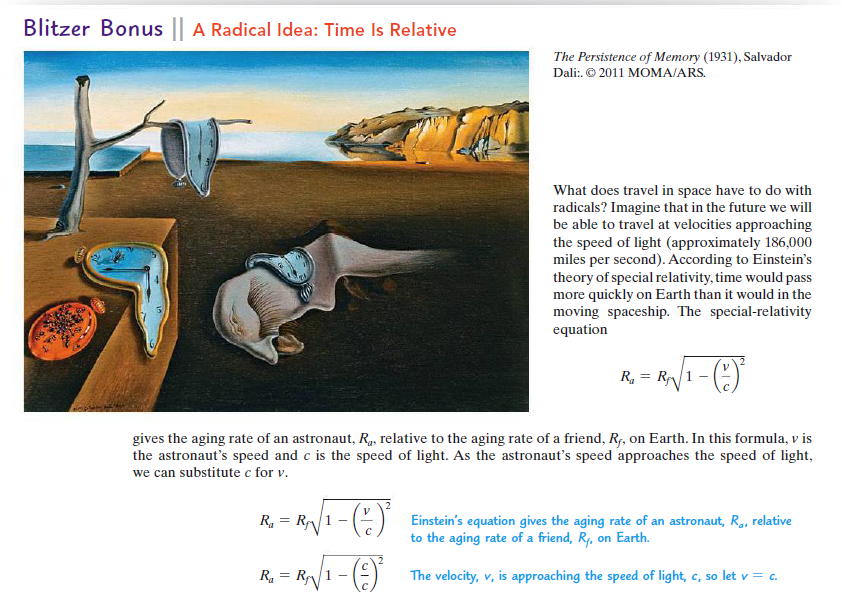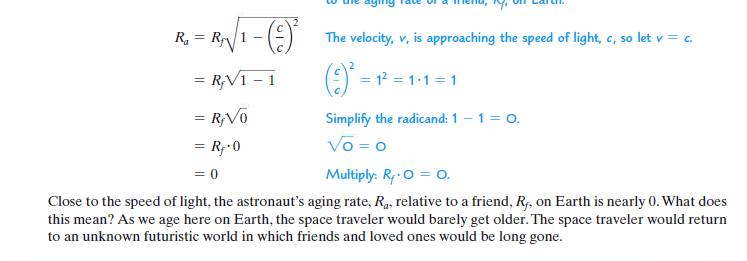Blitzer Bonus || A Radical Idea: Time Is Relative The Persistence of Memory (1931), Salvador Dali:. © 2011 MOMA/ARS. What does travel in space have to do with radicals? Imagine that in the future we will be able to travel at velocities approaching the speed of light (approximately 186,000 miles per second). According to Einstein's theory of special relativity, time would pass more quickly on Earth than it would in the moving spaceship. The special-relativity equation R, = R 1 - gives the aging rate of an astronaut, R4, relative to the aging rate of a friend, Rf, on Earth. In this formula, v is the astronaut's speed and c is the speed of light. As the astronaut's speed approaches the speed of light, we can substitute c for v. R, = R Einstein's equation gives the aging rate of an astronaut, R., relative to the aging rate of a friend, Rf, on Earth. R. = RN/1 - (9) The velocity, v, is approaching the speed of light, c, so let v = c. R. = R1 The velocity, v, is approaching the speed of light, c, so let v = c. = R;V1 – 1 (9) - = 1? = 1:1 = 1 = R;Võ Simplify the radicand: 1 – 1 = 0. = R;•0 Vo = 0 = 0 Multiply: R,-0 = O. Close to the speed of light, the astronaut's aging rate, R, relative to a friend, Rf, on Earth is nearly 0. What does this mean? As we age here on Earth, the space traveler would barely get older. The space traveler would return to an unknown futuristic world in which friends and loved ones would be long gone.
Blitzer Bonus || A Radical Idea: Time Is Relative The Persistence of Memory (1931), Salvador Dali:. © 2011 MOMA/ARS. What does travel in space have to do with radicals? Imagine that in the future we will be able to travel at velocities approaching the speed of light (approximately 186,000 miles per second). According to Einstein's theory of special relativity, time would pass more quickly on Earth than it would in the moving spaceship. The special-relativity equation R, = R 1 - gives the aging rate of an astronaut, R4, relative to the aging rate of a friend, Rf, on Earth. In this formula, v is the astronaut's speed and c is the speed of light. As the astronaut's speed approaches the speed of light, we can substitute c for v. R, = R Einstein's equation gives the aging rate of an astronaut, R., relative to the aging rate of a friend, Rf, on Earth. R. = RN/1 - (9) The velocity, v, is approaching the speed of light, c, so let v = c. R. = R1 The velocity, v, is approaching the speed of light, c, so let v = c. = R;V1 – 1 (9) - = 1? = 1:1 = 1 = R;Võ Simplify the radicand: 1 – 1 = 0. = R;•0 Vo = 0 = 0 Multiply: R,-0 = O. Close to the speed of light, the astronaut's aging rate, R, relative to a friend, Rf, on Earth is nearly 0. What does this mean? As we age here on Earth, the space traveler would barely get older. The space traveler would return to an unknown futuristic world in which friends and loved ones would be long gone.
Related questions
Question
Read the Blitzer Bonus attached herewith. The future is now: You have the opportunity to explore the cosmos in a starship traveling near the

Transcribed Image Text:Blitzer Bonus || A Radical Idea: Time Is Relative
The Persistence of Memory (1931), Salvador
Dali:. © 2011 MOMA/ARS.
What does travel in space have to do with
radicals? Imagine that in the future we will
be able to travel at velocities approaching
the speed of light (approximately 186,000
miles per second). According to Einstein's
theory of special relativity, time would pass
more quickly on Earth than it would in the
moving spaceship. The special-relativity
equation
R, = R
1 -
gives the aging rate of an astronaut, R4, relative to the aging rate of a friend, Rf, on Earth. In this formula, v is
the astronaut's speed and c is the speed of light. As the astronaut's speed approaches the speed of light,
we can substitute c for v.
R, = R
Einstein's equation gives the aging rate of an astronaut, R., relative
to the aging rate of a friend, Rf, on Earth.
R. = RN/1 - (9)
The velocity, v, is approaching the speed of light, c, so
let v = c.

Transcribed Image Text:R. = R1
The velocity, v, is approaching the speed of light, c, so let v = c.
= R;V1 – 1
(9) -
= 1? = 1:1 = 1
= R;Võ
Simplify the radicand: 1 – 1 = 0.
= R;•0
Vo = 0
= 0
Multiply: R,-0 = O.
Close to the speed of light, the astronaut's aging rate, R, relative to a friend, Rf, on Earth is nearly 0. What does
this mean? As we age here on Earth, the space traveler would barely get older. The space traveler would return
to an unknown futuristic world in which friends and loved ones would be long gone.
Expert Solution
This question has been solved!
Explore an expertly crafted, step-by-step solution for a thorough understanding of key concepts.
This is a popular solution!
Trending now
This is a popular solution!
Step by step
Solved in 4 steps with 4 images
